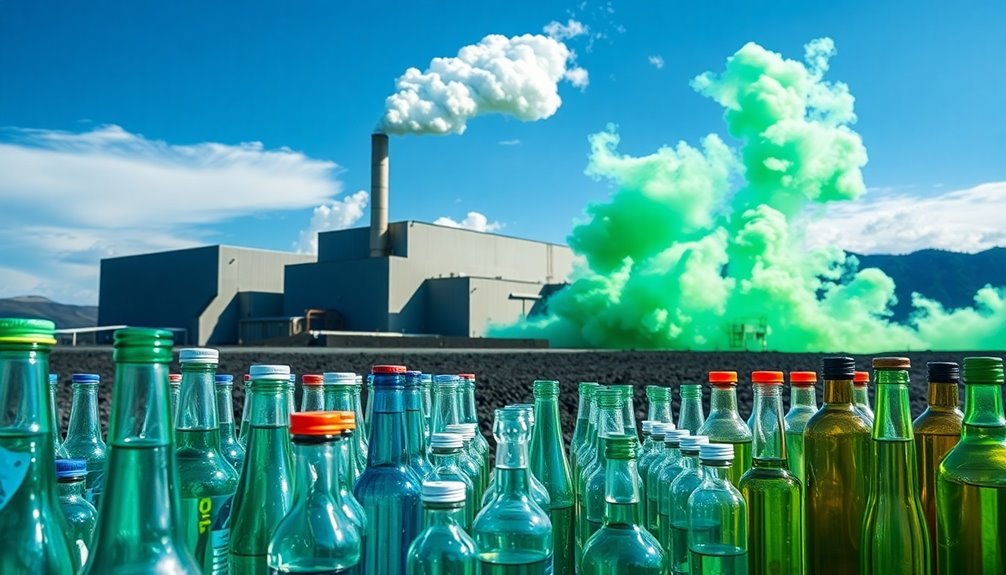Industrial waste gases are becoming a game-changer for everyday items like shampoo and detergent. Instead of relying on fossil fuels, innovative technologies convert these waste gases into sustainable products. This not only reduces emissions significantly but also supports a circular economy. You'll find that industries like steel and paper production play a key role in this transformation. Want to uncover more about how these solutions impact our environment and economy? Keep exploring!
Key Takeaways
- Industrial waste gases from steel and paper production can be converted into everyday consumer goods, such as shampoo and detergent.
- Utilizing waste gases can significantly reduce greenhouse gas emissions, with paper mills achieving up to 82% reductions.
- The Flue2Chem initiative focuses on transforming industrial waste gases into valuable surfactants, promoting sustainability.
- Large-scale production of CO2-derived products is essential for competing with fossil-based alternatives and enhancing economic viability.
- Collaboration among academia, industry, and policymakers is vital for advancing technologies that utilize waste gases sustainably.

As industries increasingly seek sustainable solutions, industrial waste gases are emerging as a viable alternative to fossil fuels. These gases primarily come from sectors like steel and paper production, where processes generate significant emissions. Instead of letting these waste gases go to waste, innovative technologies allow you to convert them into essential consumer goods such as shampoo and detergent. This not only addresses waste management but also helps reduce global warming potential drastically.
Research shows that utilizing these waste gases can lead to an 82% reduction in greenhouse gas emissions for paper mills and nearly 50% for steel mills when compared to fossil-based production methods. With the UK's consumer industries valued at £73 billion, there's a substantial market for these sustainable products. By capitalizing on industrial waste gases, you're not just supporting a circular economy; you're also contributing to significant environmental benefits.
Utilizing industrial waste gases can cut greenhouse gas emissions by up to 82%, fostering a substantial market for sustainable consumer products.
Technological innovations, such as CO2 utilization methods, play a crucial role in this transition. The Flue2Chem initiative is leading the charge, researching ways to convert industrial waste gases into surfactants for everyday consumer products. However, high costs and a limited hydrogen supply present challenges that need addressing before widespread adoption can occur. This is particularly important as new research focuses on developing efficient methods to capture and convert emissions into useful products.
Achieving large-scale production is essential for economic viability, and considerable research funding is being directed towards these advancements. As carbon capture technologies evolve, compact systems are improving efficiency while also reducing costs. You'll find that CO2 can be catalytically converted into fuel, offering fresh alternatives for energy sources.
Although CO2-derived products currently cost more than fossil-based options, growing demand for sustainability can help bridge this gap. Further investment in renewable energy infrastructure and technological advancements will enhance cost-effectiveness, opening doors for a more sustainable future. Collaboration between academia, policymakers, and industry will be crucial in driving these practices forward, ensuring a greener tomorrow.
Frequently Asked Questions
What Types of Industrial Waste Gases Can Be Used as Fuel?
You can use several types of industrial waste gases as fuel in various applications.
For instance, still gas, a mixture of hydrocarbons, is commonly utilized in refineries.
Blast furnace gas and coke oven gas play crucial roles in the iron and steel industry.
Additionally, black liquor is used in paper manufacturing, while biogas, produced from landfills, offers a renewable energy source.
Each type provides distinct advantages, enhancing efficiency and reducing environmental impact.
How Are Waste Gases Converted Into Usable Energy?
You can convert waste gases into usable energy through various methods.
For instance, incineration generates heat or electricity from burning waste, while anaerobic digestion transforms organic waste into biogas.
Gasification turns waste into syngas for energy, and pyrolysis decomposes it into bio-oil and syngas.
Each method has unique benefits, and using advanced technologies ensures minimal environmental impact, making these processes crucial for sustainable energy production and reducing reliance on fossil fuels.
What Industries Produce the Most Waste Gases?
Waste gases waft from various industries, with the energy sector leading the charge.
You'll find significant emissions in chemical manufacturing, where volatile organic compounds and nitrogen oxides escape.
Agriculture also adds to the air pollution problem, primarily through livestock.
Industrial processes, including manufacturing and waste management, contribute further, releasing greenhouse gases that threaten our environment.
It's crucial to understand these sources to tackle pollution effectively and innovate sustainable solutions.
Are There Environmental Risks Associated With Using Waste Gases?
Yes, there are environmental risks associated with using waste gases.
When you burn these gases for energy, unregulated emissions can still release harmful pollutants into the atmosphere. You might also face public health concerns, as inhaling these pollutants can lead to serious respiratory issues.
Additionally, if the technology used isn't efficient, it could contribute to further waste and environmental degradation, making it crucial to implement effective regulations and technologies.
How Cost-Effective Is Using Waste Gases Compared to Traditional Fossil Fuels?
When you compare using waste gases to traditional fossil fuels, you'll notice that current production costs for waste-derived surfactants are higher, at around $8/kg versus $3.75/kg for fossil fuels.
However, as market demand for sustainable products rises, this gap could narrow.
Investing in renewable energy and technological advancements can help make waste gas conversion more cost-effective, ultimately supporting a transition toward greener manufacturing practices that benefit both the economy and the environment.
Conclusion
In conclusion, tapping into industrial waste gases for daily use items is like turning trash into treasure. By harnessing these emissions, you're not just reducing pollution; you're also paving the way for a more sustainable future. Embracing this innovative approach can help lessen our reliance on fossil fuels, making a positive impact on both the environment and our daily lives. So, let's seize this opportunity and transform waste into a valuable resource for generations to come.









